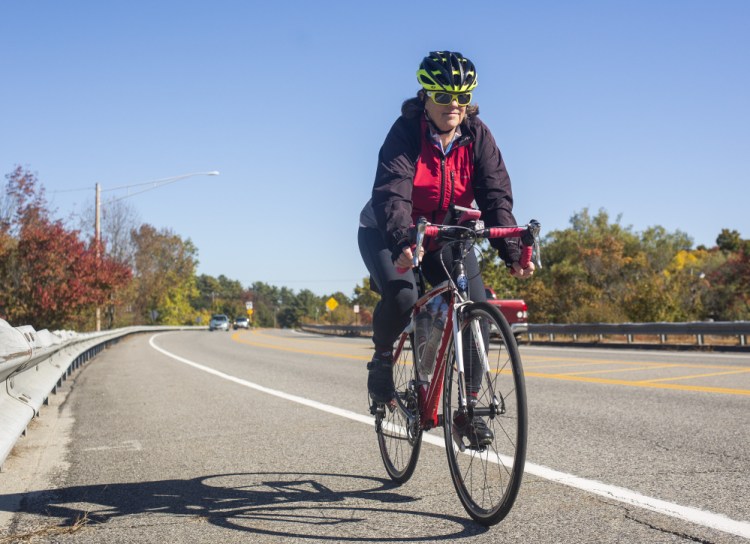For years, Dr. Mark Wheeler feared for the safety of cyclists braving a stretch of Route 1 in Woolwich.
“Number one, the cars went too fast,” said Wheeler, a retired physician who works part time at Bath Cycle & Ski in Woolwich. Although the speed limit is 35 miles per hour, he said, monitors installed by the Sagadahoc County Sheriff’s Department showed that most drivers go faster – as much as 72 miles per hour.
Cyclists headed north had to squeeze into a very narrow strip of roadway, thus adding to the danger. The shoulder went from 2 feet down to a mere 2 inches, Wheeler said.
When Wheeler and other cyclists learned that the Maine Department of Transportation planned to repave the road last year, they organized to push for improvements. About 60 people showed up for a meeting at Woolwich’s Town Hall to discuss plans with the DOT staff. As a result of those efforts, DOT reconfigured the section of Route 1 between the Bath bridge and the Taste of Maine Restaurant to eliminate one of the two northbound lanes. The additional roadway was used to widen the shoulder, so that northbound cyclists now have four feet of space.
“It’s much, much safer for the cyclists,” said Wheeler.
That change is an example of how the department’s Complete Streets policy is making a difference. Rather than planning roads only for motorists, the policy requires that DOT also consider the needs of cyclists, pedestrians, people with disabilities, seniors, children and all other users.
Maine’s Complete Streets policy took effect in 2014. At least 32 other states and the federal government have enacted similar policies. Portland, Scarborough, Yarmouth, Bangor and Fort Kent are among a growing number of Maine towns and cities that have local Complete Streets policies.
But the policies don’t have an impact unless two things happen: local advocates push to implement them, and officials work to find funding.
Patrick Adams, Maine DOT’s bicycle and pedestrian program manager, likes to cite the Woolwich project because it didn’t cost the state any extra money. Plans already were underway to repave that stretch of Route 1, so the state had to redo the lane striping.
But most bicycle and pedestrian improvements do cost money. And that’s why it’s so important to have people working at the local level to garner support.
Sue Ellen Bordwell of Yarmouth is one of those people. Since retiring from L.L. Bean six years ago, Bordwell has devoted a lot of her time to advocating for bicycle and pedestrian improvements. A former president and board member of the Bicycle Coalition of Maine, she now chairs the Maine State East Coast Greenway Committee. She also served on the committee that helped design the new Martins Point Bridge between Falmouth and Portland.
Bordwell often cycles on Route 1 to get to the Yarmouth library, the grocery store and other places in town. But she knows that many residents don’t feel safe doing so, especially if it means riding on the Route 1 bridge that crosses Main Street in the middle of Yarmouth. The bridge has narrow shoulders, and navigating the exits and entrances makes for “extremely dangerous” conditions, she said.
In 2014, DOT notified the town of plans to replace the bridge. Bordwell was appointed chair of an advisory committee that is working on plans for the new bridge.
Initially, Bordwell said, the state offered a “plain vanilla bridge” as a replacement that would not have solved most of the safety issues for those on foot or bicycle. Moreover, she said, the bridge would have acted as a barrier, discouraging people from walking or biking to churches, restaurants and other places in the downtown area.
The advisory committee recommended building a multi-use path on one side of the bridge that would connect to an existing trail, and adding a path on the other side that would provide a way for cyclists and pedestrians to reach Main Street.
Bordwell said the town convinced DOT that those improvements were needed in order to comply with both state and local Complete Streets policies. Plans also call for a flashing warning light in a crosswalk to help cyclists and pedestrians safely traverse the bridge’s southbound exit.
The bicycle-pedestrian improvements will cost almost $1 million. The town is sharing the costs with DOT and the Portland Area Comprehensive Transportation System. Work on the new bridge is expected to begin next year.
Both Route 1 projects came about because advocates made the effort to attend meetings and speak out for bicycle and pedestrian improvements.
Bordwell says that everyone benefits from roads that are safer for bicycling and walking. As she points out, they make for a “healthier, safer, cleaner, less congested town.”
Shoshana Hoose is a freelance writer who walks and bicycles in Greater Portland and beyond. Contact her at shoshanahoose@gmail.com
Send questions/comments to the editors.



Success. Please wait for the page to reload. If the page does not reload within 5 seconds, please refresh the page.
Enter your email and password to access comments.
Hi, to comment on stories you must . This profile is in addition to your subscription and website login.
Already have a commenting profile? .
Invalid username/password.
Please check your email to confirm and complete your registration.
Only subscribers are eligible to post comments. Please subscribe or login first for digital access. Here’s why.
Use the form below to reset your password. When you've submitted your account email, we will send an email with a reset code.